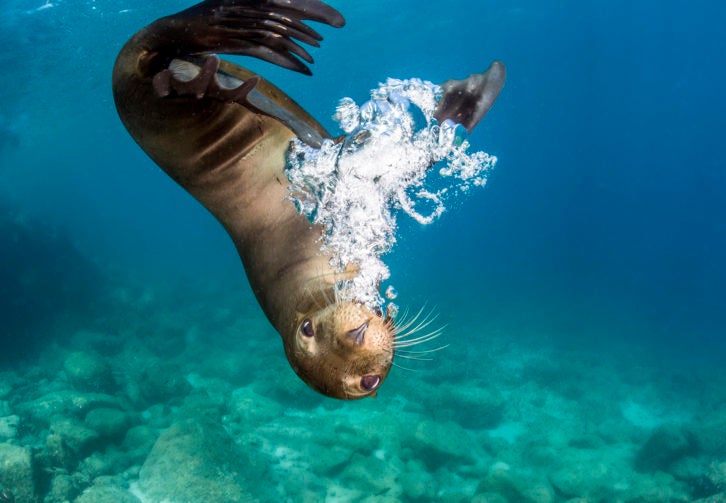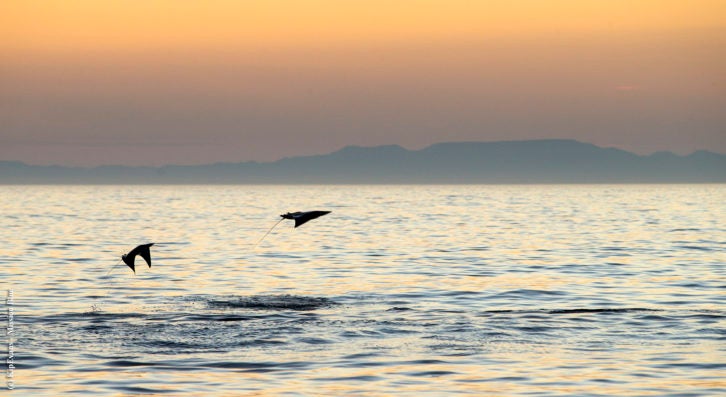The most well-known — certainly the most fun — marine scientist, conservationist, aquanaut and oceanographer alive, Dr Sylvia Earle has tirelessly advocated for the ocean for over half a century. She speaks with Kristen Shirley about her incomparable career and why she still has hope for the oceans.
The list of prestigious honors and world firsts is long for the petite oceanographer sitting in front of me. I meet Dr Sylvia Earle in Washington, DC during a busy week for science — the city is abuzz with the National Geographic Explorers Festival and the Rolex Awards for Enterprise — and she is undeniably the belle of the ball.
Everywhere we go, people strive to say hello and to get a word in with Her Deepness, the first person — not woman, person — to set foot on the deep-ocean floor; the first female Chief Scientist of the National Oceanic and Atmospheric Administration; a fellow at Harvard University; a National Geographic Society Explorer-in-Residence; and founder of the nonprofit organization Mission Blue.
People are drawn to her contagious energy, zest for life and deep empathy for all living things — and maybe they want to hear what it’s like to stand on the ocean floor, 1,250 ft deep, in an atmospheric diving suit (a JIM suit).
Lucky for me, Earle is happy to recount what it’s like to sink over a thousand feet untethered to the surface in her record-breaking dive. “As you descend, it gets bluer and bluer and bluer, and you lose the gold, you lose the red, you lose the orange. And it’s a blue… it’s an indigo everything. You know, if you looked in the mirror at even 100 feet, but especially as you go deeper, you’re blue.
“If you have lipstick on, it’s blue. When you get down to about 650 ft… you can still see light above, and it is like a deep twilight. And you begin to see bioluminescence, these little sparkles. When you get down to where I was, at about 1,250 ft with the JIM suit, it’s almost, but not totally, completely dark.
“What I could see after my eyes became accustomed to what little bit of light there was, you could see it’s kind of gray. In this direction, it’s really black.” When she touched the coral on the ocean floor, “they would just burst with blue fire.”

Hammerhead sharks at a Mission Blue Hope Spot / ©Kip Evans
If more people heard her stories, they would care deeply about the ocean, so crucial to our planet’s survival. For Earle, the lack of public awareness is the biggest challenge facing the oceans. She says, “Ignorance is killing the ocean. While formal designation of protection helps, what is most important is getting to the minds and hearts of people about why they should care.”
The ocean’s seemingly impenetrable depths can be frightening. Maybe that’s why the public cares more about space exploration than the oceans, and maybe it explains why Neil Armstrong is a national hero while Earle works quietly in the background — though both were first to leave their footprints on an untouched frontier.
Earle says several astronauts have told her that when they return from a mission, the importance of our planet is put into a new perspective for them. “They all say how they look at life differently, that when they see the vastness of the universe, here is this miracle. This blue planet that’s alive. The moon — there’s no life unless we take it along. There may be life on Mars; there’s water there, not much, and the temperature extremes are much greater than we have here. This is a just-right planet.”
Sadly, the blue on our just-right planet is in crisis. “We have a long way to go before civilization and cultures around the world acknowledge with policies, with attitudes, with behavior, that the ocean keeps us alive. And that we have to turn things around and take care of the ocean,” Earle says. Earle has dedicated her life to ocean conservation.

A sea lion appears to perform for the camera / ©Kip Evans
Now with Mission Blue she is empowering the people, allowing them to nominate special marine areas as Hope Spots. The organization works to raise awareness, advise in a scientific capacity, engage the community and create partnerships to help protect these areas. She’s seen firsthand that the best way to make something happen is to make people care — and they care most about what’s in their own communities.
Earle knows the importance of personal experience; her childhood spent at the New Jersey seaside, then growing up near the beach in Florida, cemented her love for the ocean and its strange creatures. She tells me that, as a child, she was fascinated with horseshoe crabs. “I just thought they were beautiful, wondrous, curious creatures. And there were adults who thought they were scary monsters… I would just look at them and think, ‘You don’t know what you’re talking about’.”
In the 1950s, most of the ocean was unexplored; Earle was fortunate to study at a rare place in the US with scuba tanks and regulators, so she could descend for longer than she could hold her breath. She’s spent nearly 8,000 hours underwater, some beneath the surface for up to two weeks at a time, some in a submarine and much of it diving. Earle’s enterprising spirit led her to found DOER Marine — now run by her daughter — to create equipment for expeditions.
It takes more than grit and passion to launch an expedition; it takes money and equipment, both of which were in short supply. Hearing about the difficulty — she compared her fundraising to the fable of making stone soup — exemplifies how little funding ocean exploration receives. It’s impossible to imagine Neil Armstrong cobbling together funds to build Apollo 11 in the same way.

Mobula Rays Jumping at Sunset / ©Kip Evans
After getting all of the funding, including a donation from Rolex, which also provided watches to test on the submersible’s manipulator arm, her dream came true. “We took it down off the coast of San Diego, and the satisfaction was having dreamed this up, having worked with the engineers and having started the company. And there was a submarine, and finally I got to drive it and go down under myself to 3,200 ft, which was the maximum depth it could go.”
The companies who build this equipment, like Rolex and its diving watches, also need these expeditions to test their equipment. Earle has worn a Rolex since the 1970s, usually a fabulous gold Lady-Datejust; technically, it is not a diving watch, but that doesn’t stop Earle.
“I wear this one a lot because I take it underwater, I take it in the shower, I take it to black-tie parties, I just don’t take it off. Except sometimes when I have a serious diving operation and then I use my Deepsea that goes to 4,000 meters. I don’t expect I will be outside at 4,000 meters, but if I drop the watch, I can get a submarine, go down and retrieve it, and it’ll be fine.”
And that’s just the type of woman Earle is. She would hop in a submarine, descend into the ocean’s depths and bring it back up.










